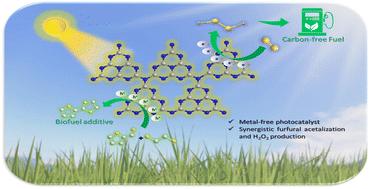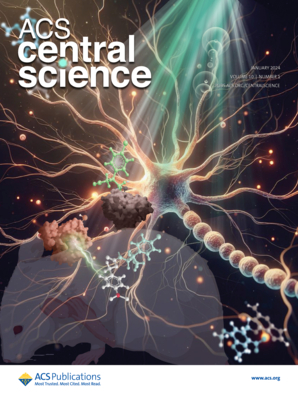Unveiling the solar-driven synergistic production of a cyclic fuel-additive and carbon-free solar fuel from biogenic furfural: mediated by a metal-free organic semiconductor
IF 12.7
1区 化学
Q1 CHEMISTRY, MULTIDISCIPLINARY
引用次数: 0
Abstract
Photocatalytic biomass upgradation to fine chemicals and fuels offers a promising strategy to address the current energy crisis and presents a prominent step towards carbon neutrality. Despite several reports in recent years, biomass valorization is still facing a lot of challenges including poor selectivity and inefficient conversion. Notably, photooxidation of biomass results in inefficient utilization of charge carriers which hampers the overall efficiency of the photocatalytic process. In the ongoing quest for effective biomass upgradation, here, we present a metal-free urea-derived carbon-nitride for the photocatalytic acetalization of furfural (Ffal) with ethylene glycol (EG) to generate a cyclic acetal i.e. 2-furyl-1,3-dioxolane (FD), a promising bio-fuel additive integrated with H2O2 production under visible light for the first time. Importantly, an 85% cyclic acetal yield is achieved in 6 h with 99% selectivity along with 162 µmol g−1 of H2O2 production. Under natural sunlight, an exceptionally high yield of FD has been achieved, reaching 70% yield, presenting the practicality of the UCN photocatalyst for the large-scale production of cyclic acetals. In situ EPR analysis, photoluminescence spectroscopy, and photo-electrochemical studies along with various control experiments elucidated the charge transfer mechanism involved in the photoredox process. Thus, the current study offers an encouraging approach for harnessing a metal-free photocatalyst to generate solar fuel coupled with biomass upgradation to fuel additives, thereby presenting a viable pathway for the sustainable production of fuels and fine chemicals.

揭示生物源糠醛在太阳能驱动下协同生产循环燃料添加剂和无碳太阳能燃料的过程:由无金属有机半导体介导
光催化生物质升级为精细化学品和燃料为解决当前的能源危机提供了一个前景广阔的战略,也是实现碳中和的重要一步。尽管近年来有一些报道,但生物质的价值化仍然面临着许多挑战,包括选择性差和转化效率低。值得注意的是,生物质的光氧化会导致电荷载体的低效利用,从而影响光催化过程的整体效率。在不断寻求有效生物质升级的过程中,我们在此提出了一种无金属脲衍生氮化碳,用于糠醛(Ffal)与乙二醇(EG)的光催化缩醛反应,生成环状缩醛,即 2-糠基-1,3-二氧戊环(FD),这是一种很有前景的生物燃料添加剂,首次在可见光下与 H2O2 生成相结合。重要的是,在 6 小时内实现了 85% 的环缩醛产量,选择性高达 99%,同时还产生了 162 µmol g-1 的 H2O2。在自然光下,FD 的产量也特别高,达到了 70%,这表明 UCN 光催化剂在大规模生产环缩醛方面的实用性。原位 EPR 分析、光致发光光谱和光电化学研究以及各种对照实验阐明了光氧化还原过程中的电荷转移机制。因此,目前的研究为利用无金属光催化剂生成太阳能燃料以及将生物质升级为燃料添加剂提供了一种令人鼓舞的方法,从而为燃料和精细化学品的可持续生产提供了一条可行的途径。
本文章由计算机程序翻译,如有差异,请以英文原文为准。
求助全文
约1分钟内获得全文
求助全文
来源期刊

ACS Central Science
Chemical Engineering-General Chemical Engineering
CiteScore
25.50
自引率
0.50%
发文量
194
审稿时长
10 weeks
期刊介绍:
ACS Central Science publishes significant primary reports on research in chemistry and allied fields where chemical approaches are pivotal. As the first fully open-access journal by the American Chemical Society, it covers compelling and important contributions to the broad chemistry and scientific community. "Central science," a term popularized nearly 40 years ago, emphasizes chemistry's central role in connecting physical and life sciences, and fundamental sciences with applied disciplines like medicine and engineering. The journal focuses on exceptional quality articles, addressing advances in fundamental chemistry and interdisciplinary research.
 求助内容:
求助内容: 应助结果提醒方式:
应助结果提醒方式:


